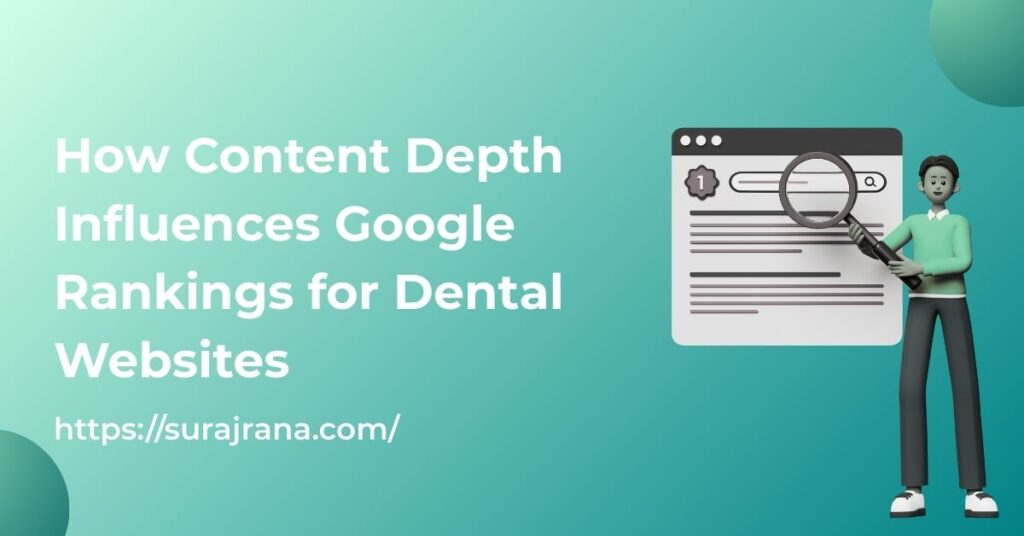In today’s digital landscape, having a dental website is only the first step. To stand out among competitors and appear prominently on Google search results, your content needs to do more than just exist—it must be meaningful, valuable, and in-depth.
Content depth is one of the most crucial, yet often misunderstood, factors that can significantly influence how well your dental website ranks on search engines.
This article breaks down what content depth really means, how it impacts Google rankings, and how dental practices can use it to their advantage.
What Is Content Depth?
Content depth refers to how comprehensively a topic is covered in a piece of content. It’s not simply about writing a long article; it’s about creating content that addresses the main topic thoroughly, answers related sub-questions, includes real value like visuals, FAQs, and examples, and is easy to understand and navigate.
A web page with great content depth doesn’t just skim the surface—it anticipates the reader’s questions and provides clear, well-structured answers.
For a dental website, this might mean covering not just what a root canal is, but how it works, recovery times, common myths, signs you need one, and aftercare tips.
A Dental SEO agency often emphasizes content depth as a core strategy to improve search rankings and user engagement for dental practices.
Why Content Depth Matters to Google
Google’s goal is to deliver the most relevant and helpful results to users. Its algorithms have become more sophisticated, especially with advancements in natural language processing. This means that pages which answer user queries in-depth tend to rank higher.
1. Matches User Intent
When someone searches “teeth cleaning procedure,” they’re not just looking for a definition. They might want to know what the process involves, whether it hurts, how often it should be done, and what the cost is.
Content depth addresses these sub-questions in one place, providing a satisfying experience for the user and increasing the chances of ranking higher.
2. Increases Time on Page
When your website offers detailed, engaging content, visitors stay longer. Google sees this as a positive ranking signal because it suggests your content is useful and relevant.
More time on page typically results in lower bounce rates and higher engagement.
3. Boosts Topical Authority
The more in-depth content you have around a subject, the more likely Google is to see your website as an authority on that topic.
For dentists, having comprehensive content on a variety of treatments—like fillings, crowns, or orthodontics—helps position your website as a go-to resource.
4. Enhances Opportunities for Internal Linking
Deep content makes it easier to link related topics together within your site. For example, a blog post on gum disease could naturally link to service pages on periodontal treatments, dental cleanings, or early warning signs—keeping users on your site longer and boosting SEO performance.
Depth vs. Length: What’s the Difference?
It’s essential to understand that content depth is not the same as content length. You can write a long article that lacks depth if it’s repetitive, off-topic, or full of fluff.
Conversely, a shorter article can be considered deep if it’s well-researched and answers multiple layers of the user’s query.
Rather than aiming for a specific word count, focus on answering all relevant questions and adding value.
Use tools like Google’s “People Also Ask,” keyword research tools, and competitor analysis to identify what users expect to find in high-ranking content.
Examples of Content Depth in Dental Websites
Dental websites have a unique advantage: dentistry is full of complex procedures and questions that patients want to understand. Here’s how content depth can be applied effectively:
1. Service Pages
Shallow service pages often contain just a few lines describing the treatment, offering little value beyond a basic definition.
For example, a typical page on dental fillings might simply state, “We offer composite fillings for cavities,” without providing any real insight into what the procedure entails or why it might be the best choice for a patient.
This kind of minimal content does little to educate or engage visitors, and as a result, it typically performs poorly in search engine rankings.
In contrast, a well-optimized and in-depth service page—crafted with Dental SEO principles in mind—would go much further.
It would explain what composite fillings are in simple, patient-friendly language, describe the step-by-step process of how they’re placed, and compare them with other filling materials such as amalgam, ceramic, or gold.
Additionally, it would cover the expected lifespan of a composite filling, address potential benefits and drawbacks, and provide realistic expectations about durability and maintenance.
A high-quality service page would also include information about insurance coverage, out-of-pocket costs, and any financing options available, which are often top concerns for prospective patients.
By incorporating a frequently asked questions (FAQ) section, the page can preemptively address common queries like “Does getting a filling hurt?” or “Can you eat immediately after the procedure?”
Finally, post-procedure care instructions—such as how to manage sensitivity, what to avoid eating, and when to schedule follow-up visits—can help patients feel more informed and reassured.
When all of these elements are present, not only does the content offer real value to users, but it also aligns with what search engines consider high-quality, authoritative content.
This is exactly what Dental SEO aims to achieve: creating content that satisfies both the user’s intent and Google’s quality standards, ultimately improving visibility and increasing patient conversions.

2. Blog Content
Many dental blogs cover topics too broadly or vaguely. Instead of posting something like “Tips for Healthy Teeth,” a more effective approach would be “The Complete Guide to Preventing Tooth Decay: Diet, Hygiene, and Professional Care.” The latter addresses the topic thoroughly and appeals to both search engines and users.
3. Patient Education
Educational content—like downloadable guides or explainer videos—adds serious depth. These can address common questions such as “What are dental implants?”,
“What happens during a root canal?”, or “What are the benefits of laser dentistry?”
Providing visual aids or downloadable PDFs helps increase trust and credibility while satisfying user intent.
How to Create Deep Content That Ranks
Here are practical ways to ensure your dental website content has the depth needed to rank well on Google:
1. Use Keyword Clusters
Instead of targeting one keyword per page, use a group of related keywords to build a comprehensive resource. For example, a page about dental crowns could also include content for terms like:
- “Types of dental crowns”
- “Dental crown procedure”
- “How long do crowns last?”
- “Temporary vs. permanent crowns”
This allows your page to answer a broader range of search queries.
2. Structure Your Content with Headers
Using clear headers (H2, H3) to break up your content makes it easier to read and helps Google understand the hierarchy of your information.
Include a table of contents for longer articles, and use bullet points or numbered lists for clarity.
3. Add Multimedia Elements
Images, diagrams, and short videos can greatly enhance content depth. For example, a visual showing the stages of gum disease can make an article much more informative and engaging.
4. Include Internal and External Links
Linking to other relevant pages on your own website helps users navigate your site more effectively and keeps them engaged longer.
Also, citing credible sources—like dental associations or medical journals—adds authority to your content.
5. Keep Content Up to Date
Outdated content loses value quickly. Schedule regular content audits every 6–12 months to ensure your information, statistics, and treatment methods are current.
How Google Evaluates Content Quality and Depth
Google uses several quality indicators to determine content ranking. These include:
- E-E-A-T: Experience, Expertise, Authoritativeness, and Trustworthiness. Deep content often reflects more E-E-A-T signals, especially when written by or attributed to a licensed dental professional.
- Engagement Metrics: Time on site, bounce rate, and pages per session all tell Google how users interact with your content.
- Content Relevance: Google looks for how closely your content matches the search query and if it satisfies the user’s intent.
Real Impact of Content Depth on Dental SEO
In practice, websites with shallow content may struggle to rank beyond the second or third page of search results.
Even if they include the right keywords, Google prefers content that goes deeper—offering valuable insights and solving user problems more thoroughly.
Dental websites that focus on content depth often see significant improvements in:
- Search engine visibility
- Patient engagement
- Lead conversion rates
When done right, deep content becomes a powerful tool for long-term success.
Where SEO for Dentist Fits In
When people hear the term SEO for dentist, they often think of things like keyword placement, backlinks, or meta descriptions. While those are important, none of them will work well if the content itself isn’t strong.
Content depth forms the backbone of a successful SEO strategy. Search engines need something valuable to rank—and deep content provides that value in spades.
Whether you manage your SEO internally or work with an agency, make sure that your strategy includes an emphasis on comprehensive, high-quality content. It’s not enough to be present online—you need to be helpful, informative, and thorough.
Conclusion
In an age where consumers expect instant, in-depth information, content depth is one of the most important SEO factors for dental websites.
It improves visibility, builds trust, and ultimately drives more patients through your doors.
By committing to content that thoroughly answers patient questions, covers topics from multiple angles, and reflects your professional expertise, your dental practice can rise through the ranks and dominate search results.
Google rewards quality—and deep, valuable content is the best way to show you’re worth the click.

My name is Suraj Rana, and I am a seasoned Dental SEO Specialist with extensive experience in the Dental SEO industry. Leveraging my deep knowledge and expertise, I help dental practices enhance their online visibility and attract more patients.


